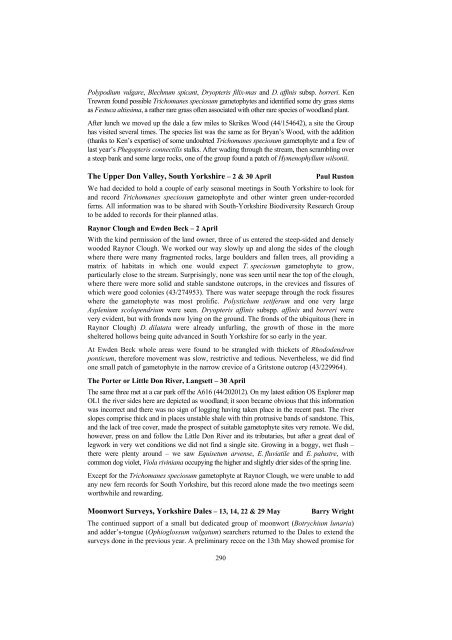REGIONAL MEETINGS - Natural History Museum
REGIONAL MEETINGS - Natural History Museum
REGIONAL MEETINGS - Natural History Museum
You also want an ePaper? Increase the reach of your titles
YUMPU automatically turns print PDFs into web optimized ePapers that Google loves.
Polypodium vulgare, Blechnum spicant, Dryopteris filix-mas and D. affinis subsp. borreri. Ken<br />
Trewren found possible Trichomanes speciosum gametophytes and identified some dry grass stems<br />
as Festuca altissima, a rather rare grass often associated with other rare species of woodland plant.<br />
After lunch we moved up the dale a few miles to Skrikes Wood (44/154642), a site the Group<br />
has visited several times. The species list was the same as for Bryan’s Wood, with the addition<br />
(thanks to Ken’s expertise) of some undoubted Trichomanes speciosum gametophyte and a few of<br />
last year’s Phegopteris connectilis stalks. After wading through the stream, then scrambling over<br />
a steep bank and some large rocks, one of the group found a patch of Hymenophyllum wilsonii.<br />
The Upper Don Valley, South Yorkshire – 2 & 30 April Paul Ruston<br />
We had decided to hold a couple of early seasonal meetings in South Yorkshire to look for<br />
and record Trichomanes speciosum gametophyte and other winter green under-recorded<br />
ferns. All information was to be shared with South-Yorkshire Biodiversity Research Group<br />
to be added to records for their planned atlas.<br />
Raynor Clough and Ewden Beck – 2 April<br />
With the kind permission of the land owner, three of us entered the steep-sided and densely<br />
wooded Raynor Clough. We worked our way slowly up and along the sides of the clough<br />
where there were many fragmented rocks, large boulders and fallen trees, all providing a<br />
matrix of habitats in which one would expect T. speciosum gametophyte to grow,<br />
particularly close to the stream. Surprisingly, none was seen until near the top of the clough,<br />
where there were more solid and stable sandstone outcrops, in the crevices and fissures of<br />
which were good colonies (43/274953). There was water seepage through the rock fissures<br />
where the gametophyte was most prolific. Polystichum setiferum and one very large<br />
Asplenium scolopendrium were seen. Dryopteris affinis subspp. affinis and borreri were<br />
very evident, but with fronds now lying on the ground. The fronds of the ubiquitous (here in<br />
Raynor Clough) D. dilatata were already unfurling, the growth of those in the more<br />
sheltered hollows being quite advanced in South Yorkshire for so early in the year.<br />
At Ewden Beck whole areas were found to be strangled with thickets of Rhododendron<br />
ponticum, therefore movement was slow, restrictive and tedious. Nevertheless, we did find<br />
one small patch of gametophyte in the narrow crevice of a Gritstone outcrop (43/229964).<br />
The Porter or Little Don River, Langsett – 30 April<br />
The same three met at a car park off the A616 (44/202012). On my latest edition OS Explorer map<br />
OL1 the river sides here are depicted as woodland; it soon became obvious that this information<br />
was incorrect and there was no sign of logging having taken place in the recent past. The river<br />
slopes comprise thick and in places unstable shale with thin protrusive bands of sandstone. This,<br />
and the lack of tree cover, made the prospect of suitable gametophyte sites very remote. We did,<br />
however, press on and follow the Little Don River and its tributaries, but after a great deal of<br />
legwork in very wet conditions we did not find a single site. Growing in a boggy, wet flush –<br />
there were plenty around – we saw Equisetum arvense, E. fluviatile and E. palustre, with<br />
common dog violet, Viola riviniana occupying the higher and slightly drier sides of the spring line.<br />
Except for the Trichomanes speciosum gametophyte at Raynor Clough, we were unable to add<br />
any new fern records for South Yorkshire, but this record alone made the two meetings seem<br />
worthwhile and rewarding.<br />
Moonwort Surveys, Yorkshire Dales – 13, 14, 22 & 29 May Barry Wright<br />
The continued support of a small but dedicated group of moonwort (Botrychium lunaria)<br />
and adder’s-tongue (Ophioglossum vulgatum) searchers returned to the Dales to extend the<br />
surveys done in the previous year. A preliminary recce on the 13th May showed promise for<br />
290
















